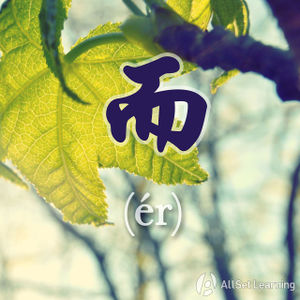Difference between revisions of "Using "er" to explain contrasting ideas"
m (Text replacement - "bùshì" to "bù shì") |
m (Text replacement - "zàijiā" to "zài jiā") |
||
| Line 51: | Line 51: | ||
<div class="liju"> | <div class="liju"> | ||
| − | * 我 今天 去 你 家 找 你 了,<em>而</em> 你 不 在 家。<span class="pinyin">Wǒ jīntiān qù nǐ jiā zhǎo nǐ le, <em>ér</em> nǐ bù | + | * 我 今天 去 你 家 找 你 了,<em>而</em> 你 不 在 家。<span class="pinyin">Wǒ jīntiān qù nǐ jiā zhǎo nǐ le, <em>ér</em> nǐ bù zài jiā.</span><span class="trans">I went to your house today to find you, but you weren't home. </span> |
* 孩子 发烧 很 严重,<em>而</em> 你 一点 都 不 关心。<span class="pinyin">Hái zǐ fāshāo hěn yánzhòng, <em>ér</em> nǐ yīdiǎn dōu bù guānxīn.</span><span class="trans">Your child has a very severe fever, but you must not care. </span> | * 孩子 发烧 很 严重,<em>而</em> 你 一点 都 不 关心。<span class="pinyin">Hái zǐ fāshāo hěn yánzhòng, <em>ér</em> nǐ yīdiǎn dōu bù guānxīn.</span><span class="trans">Your child has a very severe fever, but you must not care. </span> | ||
* 她 在 公司 很 受 欢迎,<em>而</em> 我 并 不 喜欢 她。<span class="pinyin">Tā zài gōngsī hěn shòu huānyíng, <em>ér</em> wǒ bìng bù xǐhuān tā.</span><span class="trans">She is very popular at the company, but I don't like her at all. </span> | * 她 在 公司 很 受 欢迎,<em>而</em> 我 并 不 喜欢 她。<span class="pinyin">Tā zài gōngsī hěn shòu huānyíng, <em>ér</em> wǒ bìng bù xǐhuān tā.</span><span class="trans">She is very popular at the company, but I don't like her at all. </span> | ||
Revision as of 07:35, 13 November 2020
-
Level
-
Similar to
-
Used for
-
Keywords
The conjunction 而 (ér) is used to connect two sentences that are related to each other, and is also frequently used to emphasize contrast between two parts of the sentence. In this manner, it can be seen as a word meaning "but rather." 而 is often used in a more formal or literary sense, but is also common in everyday speech.
Contents
Start with 是
Frequently you'll see the pattern in one of these two more specific forms involving the verb 是:
Structure
不是……,而是……
是……,而不是……
Strictly speaking, the 而 isn't required in either of these patterns, but it makes the contrast super clear.
Examples
- 以后 后悔 的 人 不 是 我,而 是 你 自己。The regretful person isn't me. It's you.
- 现在 要 做 的 不 是 责怪 谁 错 了,而 是 怎么 解决。Now is not the time to accuse who did it wrong, but to figure out how to resolve it.
- 我 没 说 不 是 想 骗 你 ,而 是 怕 你 不 高兴 。The reason I didn't tell you isn't that I wanted to lie to you; it's that I was afraid you would be upset.
- 我 不 是 不 想 帮 你 ,而 是 没有 能力 帮 你 。It's not that I don't want to help you, it's that I have no ability to help you.
- 重要 的 不是 你 的 外表 ,而是 你 的 内心 。What's important is not how you look on the outside, but rather what's on the inside.
- 生活 中 不是 缺少 美 ,而是 缺少 发现 美 的 眼睛 。It's not that life is lacking in beauty, but rather that we lack eyes that discover it.
- 我们 是 来 办事 的 ,不是 来 玩 的 。We're here to do our job, not to have fun.
- 你 这样 做 是 害 他 ,不是 帮 他 。By doing this you were hurting him, not helping him.
- 不好意思 ,我 是 不 小心 ,不是 故意 的 。I'm sorry. It was an accident. It wasn't on purpose.
Generalized Pattern
Structure
Sentence 1, + 而 + Sentence 2
Examples
- 我 今天 去 你 家 找 你 了,而 你 不 在 家。I went to your house today to find you, but you weren't home.
- 孩子 发烧 很 严重,而 你 一点 都 不 关心。Your child has a very severe fever, but you must not care.
- 她 在 公司 很 受 欢迎,而 我 并 不 喜欢 她。She is very popular at the company, but I don't like her at all.
As you can see, 而 comes between the two to stress the contrast.
See Also
- "On the contrary" with "fan'er"
- Conceding a point with "shi"
- Expressing "not only… but also"
- Two words for "but"
- Using "because" with "er" to indicate effect
Sources and Further Reading
Books
- HSK Standard Course 4上 (pp. 22) Anything Goes (无所不谈) →buy
- Integrated Chinese: Level 2, Part 1 (pp. 343-4) Anything Goes (无所不谈) →buy
- 卓越汉语-公司实战篇 (pp. 128, 200) 卓越汉语-公司实战篇 →buy
- Integrated Chinese: Level 2, Part 1 (pp. 277) Anything Goes (无所不谈) →buy
- New Practical Chinese Reader 4 (新实用汉语课本4) (pp. 20) Anything Goes (无所不谈) →buy
- 40 Lessons for Basic Chinese Course (基础汉语40课下册) (pp. 516) [ →buy]
Websites
- Yale Chinese Usage Dictionary: Usage of 而



